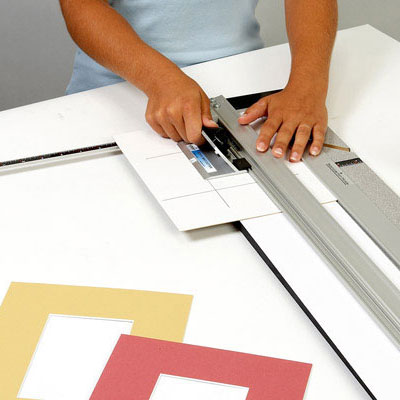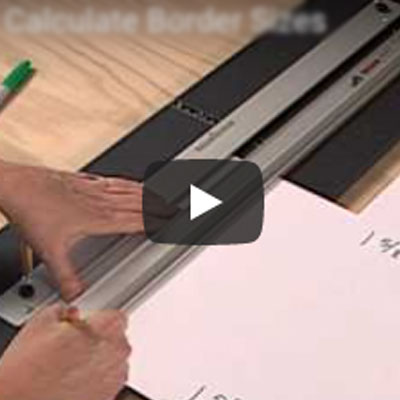Part Three in a Series
In part two of this series we explored the question, How Much Should Picture Framing Cost? In that article we concluded that framing should probably cost a good deal less than most people are presently paying. Now we ask the question, how can you reduce the cost of framing?
First, recognize that when it comes to picture framing, labor and materials are involved. To hold down costs you are going to have to deal with both.
A Common Misconception about the Cost of Framing
In an effort to hold down costs, many consumers purchase ready-made frames (in other words, pre-assembled frames) because they're cheaper. But the cost of labor to make the art fit into a frame that doesn't conform in size to the art may be greater than you think, and the final result may look awkward or compromised.
Another approach is to use custom sectional frames – that is, picture frames cut to the size specified and ready to be assembled without tools. Custom sectional frames can be found at a variety of websites.
Custom sectional frames are assembled with a slot-and-peg system that is relatively quick and easy and doesn't require any tools. But their greatest virtue lies in the fact that you can order them in any size you need them.
Example #1: A Poster Print costing $75
So let's say you have a poster that costs $75. Your objective is to frame it for a price that does not exceed the value of the art. To frame it for $75 or less, start with a custom sectional frame that costs $50 or less. Sites that sell custom sectional frames usually have a wide variety to choose from.
When ordering the frame, order it in the same size as the artwork. At the same time, from the same site, order the foamboard backing and Plexiglass. The total cost, including shipping, likely won't exceed $75.
Since everything is cut to the size and easy to assemble, the labor is kept to a minimum. Bingo! You've achieved your goal. The framing does not exceed the cost of the art.
Notice that the above example did not include a mat. A mat is not essential when the artwork is a poster and you have the flexibility to order the frame in the same size as the art. But if you would like a mat, you could add one for $6-$12.
Example #2: An Original Watercolor by an Unknown Artist
Let's look at another example. Let's say the art is an original watercolor painted by a friend. The value of the art is unknown. In a hundred years it might be worth a lot, or it might be worth nothing. In any case, you want it to be presentable for the duration of your own life, a matter of 50 or 60 years.
Watercolors should be matted. So you will definitely need a mat for this. But what kind of mat? Does the mat need to be a conservation grade mat board that costs $15-$40? Or can you get away with a regular mat board costing $6-$12?
Regular mat board is made of wood pulp and is therefore potentially acidic, but these days all regular mat board has been treated with calcium carbonate to dramatically reduce potential damage due to acid contamination. Time studies suggest that the introduction of calcium carbonate into mat board can keep potential acidity from becoming a threat to artwork for as much as 100 years.
If you are looking for 50 or 60 years of protection, regular mat board ought to do the trick. If it turns out 30 years from now that your friend has become a famous artist whose work is greatly in demand, you can reframe it at that time. All you need for now is enough protection to get you from here to there.
So the mat costs $10, the Plexiglass and foamboard backing should cost about the same, which means the total investment in constituents should be about $30. If you hold the cost of the frame to about $80, the total price to frame your friend's watercolor should be about $125.
Example 3: A Black & White Digital Print in an Odd Size
Finally, let's look at a situation where the art is a black and white digital print valued at less than $20. If the print is a standard size, we can buy a ready-made frame and be done with it for a price that won't exceed $20. But if the print is an unusual size, we will have to custom frame it, and that's going to cost more. So how low can we go?
Understand, the cost of the frame is always the lion's share of the cost of picture framing. So if we're going to bring this in at a reasonable cost we're going to have to bring down the cost of the frame.
One way to do this is to use metal or polystyrene frames. Metal and polystyrene frames (which are plastic) are often half the price of wood frames. And don't be put off by the idea of a plastic frame. We are not talking about a piece of cheap plastic trim here. Polystyrene frames are indistinguishable from wood frames when hanging on the wall, and if you need any further confirmation of the value of polystyrene frames, take a close look at the ready-made frames being offered at the big box stores; many of them are polystyrene frames, although they look like wood.
Order metal or polystyrene frames as custom sectional frames in the size you specify. For an odd-sized print that is 16"x20" or smaller it should be no problem to find a frame that costs under $20. Skip the mat and order the frame in the same size as the print. You will still need Plexiglass glazing and foamboard backing. But there is no reason you can't accomplish all this for under $40.
The key to the whole thing is your willingness to assemble the frame yourself and cut the mat. If you insist on having someone else do this for you, you will probably not be able to hold down the cost of framing. But if you are willing to do so, the cost of picture framing can be reduced and made entirely reasonable, no matter what the art.












